

Places to Visit
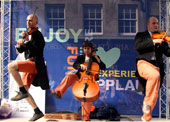 One of the main industries in Edinburgh is Tourism and the purpose of this web site is to give a few pointers to what the City has to offer to our visitors for what ever reason they have arrived in the Capital. It does not matter if you are here on business, for a few days, overnight or on holiday. There will be something to suit your needs. Edinburgh is a vibrant modern city and caters for tourism all the year round. However there are some attractions that have specific dates. The four main ones being the Military Tattoo, the Edinburgh International Festival, the largest arts festival in the world and the Fringe which occupy the month of August. The photograph on the left shows street entertainers from the fringe performing on the Royal Mile. The fourth being the New Year party and that is the largest new year party in the world. That of course runs over the Festive season. More will be said about these venues later. The attractions listed here are some of the main ones. It is a guide to what the city has to offer. So carry on reading
One of the main industries in Edinburgh is Tourism and the purpose of this web site is to give a few pointers to what the City has to offer to our visitors for what ever reason they have arrived in the Capital. It does not matter if you are here on business, for a few days, overnight or on holiday. There will be something to suit your needs. Edinburgh is a vibrant modern city and caters for tourism all the year round. However there are some attractions that have specific dates. The four main ones being the Military Tattoo, the Edinburgh International Festival, the largest arts festival in the world and the Fringe which occupy the month of August. The photograph on the left shows street entertainers from the fringe performing on the Royal Mile. The fourth being the New Year party and that is the largest new year party in the world. That of course runs over the Festive season. More will be said about these venues later. The attractions listed here are some of the main ones. It is a guide to what the city has to offer. So carry on reading
Royal Yacht Britannia
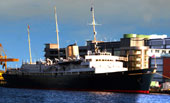 The Royal yacht Britannia was built at John Brown's Ship yard and was launched on the River Clyde, Glasgow on 16th April 1953. Ironically that was 209 years to the day of the anniversary of the Battle of Culloden. The last battle to be fought on British soil involving the British Army and the Jacobite army under the command of Charles Edward Stuart in his bid to regain the British crown to the Stuart dynasty. The yacht was Her Majesty the Queen's floating palace for over 40 years. During it's long career, the Royal yacht with Her Majesty aboard traveled the oceans of the world visiting over 135 countries promoting the interests of the United Kingdom. All the crew were serving members of the Royal Navy.
The Royal yacht Britannia was built at John Brown's Ship yard and was launched on the River Clyde, Glasgow on 16th April 1953. Ironically that was 209 years to the day of the anniversary of the Battle of Culloden. The last battle to be fought on British soil involving the British Army and the Jacobite army under the command of Charles Edward Stuart in his bid to regain the British crown to the Stuart dynasty. The yacht was Her Majesty the Queen's floating palace for over 40 years. During it's long career, the Royal yacht with Her Majesty aboard traveled the oceans of the world visiting over 135 countries promoting the interests of the United Kingdom. All the crew were serving members of the Royal Navy.
In war time Britannia was so designed she could be converted into a hospital ship for wounded members of the armed forces of the United Kingdom. In 1994 economics took it's toll and the Government announced Britannia would be taken out of service. The Yacht was decommissioned on the 11th December 1997 at Portsmouth. Britannia was the 83rd and last of a long line of Royal Yachts that dates back in history to the reign of King Charles in 1660. But Britannia would not be heading for the scrap yard. The government put out to tender bids from cities all over the United Kingdom to give her a new home. The bid was won by the City of Edinburgh and she is now permanently moored at the port of Leith. Her status is now a five star attraction and the most prestigious corporate hospitality venue in the United Kingdom. I bet you cannot wait to get home to tell the Jone's that you had dinner on the same table on the Britannia,that the Royal family dined for over forty years. Rightly so.
Edinburgh Castle
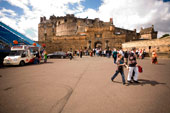 The French have castle's, the Spanish have castle's and amongst others the English have castle's. Travel anywhere in the world and mention the word castle and with out doubt Edinburgh Castle is the one that springs to mind. Stand on it's battlements and a thousand years of history have past where you are standing. One thing that dominates the skyline of Edinburgh is the Castle. It stands on a volcanic rock some 80 meters high and one can see why it was chosen as a site for defense purposes. Evidence has suggested that man has occupied the area of the castle since around 900 BC.By the time the Romans paid Scotland a visit around AD 80 it was a defensive structure. The rock it stands on was formed some 70 million years ago. During the reign of King David around 1140 it became a royal fortress. Over the years the Castle has fallen to the English regained by the Scots on several occasions.
The French have castle's, the Spanish have castle's and amongst others the English have castle's. Travel anywhere in the world and mention the word castle and with out doubt Edinburgh Castle is the one that springs to mind. Stand on it's battlements and a thousand years of history have past where you are standing. One thing that dominates the skyline of Edinburgh is the Castle. It stands on a volcanic rock some 80 meters high and one can see why it was chosen as a site for defense purposes. Evidence has suggested that man has occupied the area of the castle since around 900 BC.By the time the Romans paid Scotland a visit around AD 80 it was a defensive structure. The rock it stands on was formed some 70 million years ago. During the reign of King David around 1140 it became a royal fortress. Over the years the Castle has fallen to the English regained by the Scots on several occasions.
The castle, in the care of Historic Environment Scotland, is Scotland's most and the United Kingdom's second most-visited paid tourist attraction, with over 2.1 million visitors in 2018 and over 70 percent of leisure visitors to Edinburgh visiting the castle. As the backdrop to the Edinburgh Military Tattoo during the annual Edinburgh Festival the castle has become a recognisable symbol of Edinburgh and of Scotland. Each year in August the Castle is the venue for the Edinburgh Military Tattoo. This is a splendid event and tickets are sold out two or three years prior to the display. At the end of the tattoo and during the new year party a spectacular firework display is held on the battlements and can be seen for miles around. If you are unable to book a ticket through official sources there are internet sites on the web who buy and sell tickets for this event. A search of the web will direct you to one of your choice. If you follow the links given once again you can plan your holiday on what to do and what to see from the comfort of your own home.
Palace of Holyrood House
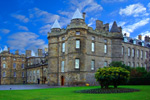 While Edinburgh Castle dominates the top of the Royal Mile the Palace of Holyrood House dominates the bottom. It is the official residence of of the British Monarch in Scotland. The Palace grew from a royal guest house which was attached to Holyrood Abbey, and added to by James IV as he prepared to marry Margaret Tudor in 1503. The tower which contains the Royal apartment were constructed by James V around 1528 and he reconstructed the west front in Scottish Renaissance style in 1535. The second wife of James V was Mary of Guise. Their daughter was Mary who was born in Linlithgow Palace on the 8th December 1542 and six days later on the death of her father she became Mary, Queen of Scots.
While Edinburgh Castle dominates the top of the Royal Mile the Palace of Holyrood House dominates the bottom. It is the official residence of of the British Monarch in Scotland. The Palace grew from a royal guest house which was attached to Holyrood Abbey, and added to by James IV as he prepared to marry Margaret Tudor in 1503. The tower which contains the Royal apartment were constructed by James V around 1528 and he reconstructed the west front in Scottish Renaissance style in 1535. The second wife of James V was Mary of Guise. Their daughter was Mary who was born in Linlithgow Palace on the 8th December 1542 and six days later on the death of her father she became Mary, Queen of Scots.
In 1558 Mary had married into the French Royal family and on the death of her husband she returned to Edinburgh. She married her first cousin Henry Stewart, Lord Darnley. Darnley thought David Rizzio the secretary to the Queen was having an affair, and Protestant Scottish Lords though he was a papal agent. On 9th March 1566 in her apartments in the Palace and in her presence the Lords and her husband murdered Rizzio. She was six months pregnant. On 19th June 1566 in Edinburgh Castle she gave birth to her son James. He would later become James VI of Scotland and I of England. The Palace went through many phases bringing it up to the present day. It is well worth a visit.
Holyrood Park
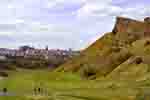 Known as Holyrood Park it is probably the largest park of a untamed nature that sits in the centre of any major city any where in the world. The park is entirely surrounded by the City of Edinburgh. It is also named Queens Park as it is the property of HM The Queen. Each year, in August the cast of the festival from the likes of the Tattoo and those part of the International Festival, march through the park. Right at the heart of the park is a hill known as Arthur Seat. This hill is a extinct volcano which last erupted around 350 to 400 million years ago. That is some 400 times longer than man has been on this earth and some one tenth of the history of the earth. The lava flows are still very much in evidence. From the top a lovely panoramic opens up and you can view the entire city. A road know as the Radical Road circles the entire hill. It is opened to vehicles.
Known as Holyrood Park it is probably the largest park of a untamed nature that sits in the centre of any major city any where in the world. The park is entirely surrounded by the City of Edinburgh. It is also named Queens Park as it is the property of HM The Queen. Each year, in August the cast of the festival from the likes of the Tattoo and those part of the International Festival, march through the park. Right at the heart of the park is a hill known as Arthur Seat. This hill is a extinct volcano which last erupted around 350 to 400 million years ago. That is some 400 times longer than man has been on this earth and some one tenth of the history of the earth. The lava flows are still very much in evidence. From the top a lovely panoramic opens up and you can view the entire city. A road know as the Radical Road circles the entire hill. It is opened to vehicles.
The photograph to the left shows part of the park with part of the volcano remains known as Salisbury Crags. Part of the Radical Road can be seen in the foreground, and the Castle in the centre left. There are three lochs in the park. They are Dunsapie, St Margaret's, and Duddingston. The later being the only natural loch, the other two being man made. There are several entrances to the park, one being where the Scottish Parliament and the Palace of Holyrood House abut the park. If you like hill walking, birds, picnics and a general good day out. This place is worth a visit. On Arthur Seat and particularly in the area of the Crags, do not be silly. The consequences could be fatal.
The Royal Mile

Running between the Castle and Holyrood Palace it was described by Daniel Defoe in 1726 as "Perhaps the largest, longest and finest streets for buildings and number of inhabitants, not only in Britain, but in the world". The castle is shown on the left. From the top to the bottom it takes in the Esplanade, Castlehill, Lawnmarket, High Street, Netherbow, Canongate and Abbey Strand. It is the heart of the Old Town. In the 1800 the building down the Royal Mile were cramp. Due to lack of space building could only go one way and that was upwards. This in turn led to bad sanitation. In those days to get rid of urine on the upper floors the occupants would open a window, shout gardaloo and toss the contents of the potty out the window. A bit annoying if you were wearing your Sunday best and happen to pass by! But worse. The housing conditions could be described as dangerous and dicing with what could be described as a brilliant servant but an evil master. Fire. On 15th November 1824 the Old Assembly Close ran from the High Street downwards into the Cowgate. The premises of James Kirkwood an engraver were sited there.
During the night a pot of linseed oil in the workshop burst into flames What followed was devastating. The fire raged for about three days and by the time it was extinguished a large part of the Old Town was razed and thirteen people died. Hundreds were left homeless. It became known as the Great Fire of Edinburgh. There is one good outcome from this fire. It knocked heads together and so began the development of the integrated fire brigades in Britain. The pioneer of this was James Braidwood who became known as the father of the British Fire Service.

The attached photograph on the left is of the Deacon Brodie Tavern. It is sited on the junction of the Lawn Market and Bank Street. It was named after William Brodie who by day was a pillar of society and by night a thief and house breaker. He was hanged nearby. Brodie inspired Robert Louis Stevenson to write the novel The Strange Case of Dr Jekyll and Mr Hyde. The entire length of the Royal Mile is a warren of Closes and premises of great interest. During the Festival in August street performers from the fringe entertain the public. A few links to the more widely visited places are on the navigation bar to the left. The list is endless.
The Forth Bridges
 Without doubt three of the most famous civil engineering feats any where in the world that stand together less than a mile apart. They are sited just to the north of Edinburgh and span a mile and a half of water over the River Forth. They are the Forth Rail Bridge, the Queensferry Crossing and the Forth Road Bridge.The technology that apply span three seperate centuries. One having been opened in 1890 by the Prince of Wales and the other by HM the Queen in 1964. The last in 2017.Construction of the Forth Rail Bridge started in 1873 after the Forth Bridge Railway Company had been set up. The principal designer being Thomas Bouch. His intention was to construct a forth rail bridge with a central tower some 600 feet high. Shortly after he began preparation the bridge he had designed across the River Tay at Dundee collapsed with heavy loss of life. Work on the Forth Rail Bridge was cancelled and put on hold. However after pressure from the railway companies work resumed. Sir John Fowler and Benjamin Baker were appointed engineers. The principal contractor was Sir William Arrol. The bridge they designed was of the cantilever type consisting of three diamond shaped towers. The towers are 340 feet high and carry a dual railway line 150 feet above the Forth.
Without doubt three of the most famous civil engineering feats any where in the world that stand together less than a mile apart. They are sited just to the north of Edinburgh and span a mile and a half of water over the River Forth. They are the Forth Rail Bridge, the Queensferry Crossing and the Forth Road Bridge.The technology that apply span three seperate centuries. One having been opened in 1890 by the Prince of Wales and the other by HM the Queen in 1964. The last in 2017.Construction of the Forth Rail Bridge started in 1873 after the Forth Bridge Railway Company had been set up. The principal designer being Thomas Bouch. His intention was to construct a forth rail bridge with a central tower some 600 feet high. Shortly after he began preparation the bridge he had designed across the River Tay at Dundee collapsed with heavy loss of life. Work on the Forth Rail Bridge was cancelled and put on hold. However after pressure from the railway companies work resumed. Sir John Fowler and Benjamin Baker were appointed engineers. The principal contractor was Sir William Arrol. The bridge they designed was of the cantilever type consisting of three diamond shaped towers. The towers are 340 feet high and carry a dual railway line 150 feet above the Forth.
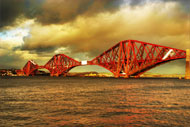 In the seven year of it's construction, 55,000 tons of steel held together by 8 million rivets and 640,000 cubic feet of granite were used. Fifty seven men lost their life's and the last rivet was driven home on 4th March 1890 by the then Prince of Wales who later became HM Edward VII. On 1st January 1948 the owning company was nationalised by the British Government. Under the government of Margaret Thatcher it was privatised and is now run as a private company. It now cost more to paint the steel structure than it did to construct. About a half mile to the west at South Queensferry stands the Forth Road Bridge. In the 11th century Margaret the Queen Consort of Malcolm III founded the ferry here and that is why it is called Queensferry. But as years rolled on and traffic became a problem there was a out cry to build a bridge without the use of a ferry. In 1936 the Kincardine Bridge some 15 mile upstream to the west was opened.
In the seven year of it's construction, 55,000 tons of steel held together by 8 million rivets and 640,000 cubic feet of granite were used. Fifty seven men lost their life's and the last rivet was driven home on 4th March 1890 by the then Prince of Wales who later became HM Edward VII. On 1st January 1948 the owning company was nationalised by the British Government. Under the government of Margaret Thatcher it was privatised and is now run as a private company. It now cost more to paint the steel structure than it did to construct. About a half mile to the west at South Queensferry stands the Forth Road Bridge. In the 11th century Margaret the Queen Consort of Malcolm III founded the ferry here and that is why it is called Queensferry. But as years rolled on and traffic became a problem there was a out cry to build a bridge without the use of a ferry. In 1936 the Kincardine Bridge some 15 mile upstream to the west was opened.
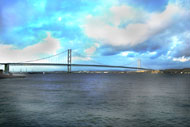 This did not ease the traffic problem and demand for a crossing between Edinburgh and Fife prompted the British Government in 1947 to set up the Forth Road Bridge Joint Board. In 1958 a final plan for the construction of the bridge was approved and shortly afterwards work began.The bridge was opened by HM The Queen and the Duke of Edinburgh on 4th September 1964. At the time of it's construction it was the largest suspension bridge outside the the United States. In total it is just over a mile long. The bridge is a vital link between the south of Scotland and the north. On the year of opening, the bridge carried 1,434,500 vehicles in total per year. By 1997 this leapt to 20,326,000 in total per year. A photogaph of it is on the left.
This did not ease the traffic problem and demand for a crossing between Edinburgh and Fife prompted the British Government in 1947 to set up the Forth Road Bridge Joint Board. In 1958 a final plan for the construction of the bridge was approved and shortly afterwards work began.The bridge was opened by HM The Queen and the Duke of Edinburgh on 4th September 1964. At the time of it's construction it was the largest suspension bridge outside the the United States. In total it is just over a mile long. The bridge is a vital link between the south of Scotland and the north. On the year of opening, the bridge carried 1,434,500 vehicles in total per year. By 1997 this leapt to 20,326,000 in total per year. A photogaph of it is on the left.
 Because of safety fears regarding the Forth Bridge and the amount of traffic it carried. The Scottish Govenment decided to ease the burden and the Queensferry Crosssing was constructed.The Queensferry Crossing opened to traffic on 30 August 2017. The photograph to the left was taken by me about 3 days before it was opened This forms the centrepiece of a major upgrade to the cross-Forth transport corridor in the east of Scotland. The 1.7 miles (2.7km) structure is the longest three-tower, cable-stayed bridge in the world and also by far the largest to feature cables which cross mid-span. This innovative design provides extra strength and stiffness, allowing the towers and the deck to be more slender and elegant.After around a year of complex, technical competitive dialogue with the potential bidders for the project, the Principal Contract to build the new bridge and connecting roads was awarded in April 2011 to the Forth Crossing Bridge Constructors (FCBC) consortium. The successful tender price of £790m was significantly below the original estimated price range of £900 to £1.2 billion. FCBC is a consortium of Hochtief from Germany, American Bridge from Pittsburgh, USA, Dragados from Spain and Morrison Construction from Scotland.
Because of safety fears regarding the Forth Bridge and the amount of traffic it carried. The Scottish Govenment decided to ease the burden and the Queensferry Crosssing was constructed.The Queensferry Crossing opened to traffic on 30 August 2017. The photograph to the left was taken by me about 3 days before it was opened This forms the centrepiece of a major upgrade to the cross-Forth transport corridor in the east of Scotland. The 1.7 miles (2.7km) structure is the longest three-tower, cable-stayed bridge in the world and also by far the largest to feature cables which cross mid-span. This innovative design provides extra strength and stiffness, allowing the towers and the deck to be more slender and elegant.After around a year of complex, technical competitive dialogue with the potential bidders for the project, the Principal Contract to build the new bridge and connecting roads was awarded in April 2011 to the Forth Crossing Bridge Constructors (FCBC) consortium. The successful tender price of £790m was significantly below the original estimated price range of £900 to £1.2 billion. FCBC is a consortium of Hochtief from Germany, American Bridge from Pittsburgh, USA, Dragados from Spain and Morrison Construction from Scotland.
Calton Hill
 One of the main hills in Edinburgh is known as Caton Hill. It is right in the City Centre just to the east of Princes Street and easily identified by what could be described as a Acropolis of ancient Greece. It is in fact the National Monument. It was built to honour those who died in the Napoleonic wars. Work started in 1822 but shortly after funds ran out. It was never completed and became known as Edinburgh's disgrace. A view from the top of Calton Hill looking westwards is shown on the photograph to the left. Another monument on top of the Calton Hill is the Nelson Monument. It was built to commemorate Lord Nelson's victory at Trafalgar. A photograph of the National Monument and the Nelson Monument is on the Photographs link on the side bar or click here to see. Calton Hill also boasts two observatories.
One of the main hills in Edinburgh is known as Caton Hill. It is right in the City Centre just to the east of Princes Street and easily identified by what could be described as a Acropolis of ancient Greece. It is in fact the National Monument. It was built to honour those who died in the Napoleonic wars. Work started in 1822 but shortly after funds ran out. It was never completed and became known as Edinburgh's disgrace. A view from the top of Calton Hill looking westwards is shown on the photograph to the left. Another monument on top of the Calton Hill is the Nelson Monument. It was built to commemorate Lord Nelson's victory at Trafalgar. A photograph of the National Monument and the Nelson Monument is on the Photographs link on the side bar or click here to see. Calton Hill also boasts two observatories.
The old observatory built in 1792 and the new observatory built in 1818. From the top a wonderful panoramic view of Edinburgh unfolds. Looking northwards you can see the Port of Leith the coast of Fife and a view of the Forth from the Forth Bridges to the west following the course of the river eastward to the Bass Rock. It is a splendid venue for a picnic. Directly across the road is the entrance to the old Calton Cemetery. Many notable Scots are buried here, including the 18th century Scottish philosopher David Hume. To the front of his mausoleum is the first statue to be erected outside the United States of Abraham Lincoln. It was erected in 1893 in memory of Scottish soldiers who fought in the American Civil war. A photograph of the statue can be seen if you click the Photographs link on the left or click here. In the last day of April the Hill is the venue for the annual Beltane Fire Fstival. Around 12,000 people attend this festival each year.
Edinburgh Zoo
Situated on the main road to Glasgow and between Murrayfield Rugby Stadium and the village of Corstorphine, some 3 miles west of the City centre, is one of the worlds premier zoo's. It is Edinburgh Zoo. The zoo sits on Corstorphine hill and overlooks the valley looking southwards towards the Pentland Hills. It is owned by the Royal Zoological Society of Scotland and was opened just before the First World War. It covers an area of some 83 acres and houses over a thousand species of animals. Many of them endangered. The Zoo is one of Europe's leading centre's of conservation in the world and works very closely with other countries in this field. It is opened all the year round. It is well worth a visit and caters for all age groups.You can buy tikets on line here.
Canongate Kirk
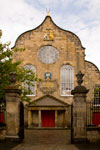 In its long history the Canongate Kirk has had two buildings. The Abbey of the Holyrood, now lying in ruins beside the Palace of Holyroodhouse and the present one sited in the Canongate on the Royal Mile near the Scottish Parliament. It has a Royal beginning. King David I was riding alone in a forest nearby when he was attacked and unhorsed by a white stag. On being attacked he saw a vision of the Holy Cross (or Rood). The stag took flight. In thanksgiving for his deliverance the King founded the Abbey in 1128 serving both as a Parish Church and a Chapel Royal.where many of the Sovereigns of old were baptized, married crowned and buried. The last King to be crowned there was Charles I in 1633. Throughout the church the legend of King David is well depicted even on the outside. On the apex of the front wall there is a gilded stags head and antlers which were presented to the Kirk by George VI. It can be seen on the photograph on the left.
In its long history the Canongate Kirk has had two buildings. The Abbey of the Holyrood, now lying in ruins beside the Palace of Holyroodhouse and the present one sited in the Canongate on the Royal Mile near the Scottish Parliament. It has a Royal beginning. King David I was riding alone in a forest nearby when he was attacked and unhorsed by a white stag. On being attacked he saw a vision of the Holy Cross (or Rood). The stag took flight. In thanksgiving for his deliverance the King founded the Abbey in 1128 serving both as a Parish Church and a Chapel Royal.where many of the Sovereigns of old were baptized, married crowned and buried. The last King to be crowned there was Charles I in 1633. Throughout the church the legend of King David is well depicted even on the outside. On the apex of the front wall there is a gilded stags head and antlers which were presented to the Kirk by George VI. It can be seen on the photograph on the left.
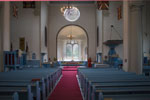 The kirk is recognized as the Military church in the Capital. Above the nave hang the old Colours of the 1st Battalion the Kings Own Scottish Borderers and that of the 7th/9th Royal Scots (Dandy 9th). On the 350th anniversary of the raising of the Royal Scots, the Royal Regiment, the oldest Regiment in the British Army, 1st of Foot and Right of the Line they adopted the Kirk as their Regimental Church. In the memorial chapel there is a small glass containing sand from the beaches of Dunkirk a memorial to the Dunkirk Veteran's Association. The Roll of Honour of the 603 (City of Edinburgh) Squadron the Royal Air Force was unveiled by HM The Queen in 1989. On 16th October 1939 the Squadron shot down a Junkers Ju-88 just east of Dalkeith, Midlothian. It was the first aircraft to be shot down in the Second World War. A photograph of the interior is shown on the left.
The kirk is recognized as the Military church in the Capital. Above the nave hang the old Colours of the 1st Battalion the Kings Own Scottish Borderers and that of the 7th/9th Royal Scots (Dandy 9th). On the 350th anniversary of the raising of the Royal Scots, the Royal Regiment, the oldest Regiment in the British Army, 1st of Foot and Right of the Line they adopted the Kirk as their Regimental Church. In the memorial chapel there is a small glass containing sand from the beaches of Dunkirk a memorial to the Dunkirk Veteran's Association. The Roll of Honour of the 603 (City of Edinburgh) Squadron the Royal Air Force was unveiled by HM The Queen in 1989. On 16th October 1939 the Squadron shot down a Junkers Ju-88 just east of Dalkeith, Midlothian. It was the first aircraft to be shot down in the Second World War. A photograph of the interior is shown on the left.
Craigmiller Castle
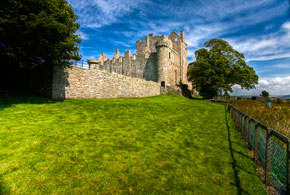 Sited some 3 miles south east of the city centre is Craigmillar Castle. It is a extremely well preserved medieval castle dating from the 14th century. It was built by the Preston family who were the Feudal Barons of Craigmillar and building continued through the 15th and 16th century. In 1660 the castle was sold to Sir John Gilmour who at that time was Lord President of the Court of Session who carried out further alterations. In 1566 following the birth of her son, the future James VI of Scotland and I of England. Mary, Queen of Scots was in convalescence at the castle. She arrived there on the 20th November 1566 and departed on the 7th December of the same year. During her stay a bond was made to rid her of Henry Stuart, Lord Darnley, who was her husband. Over the years the castle fell into ruins and was finally abandoned by the Gilmours. It is now owned by Historic Scotland.
Sited some 3 miles south east of the city centre is Craigmillar Castle. It is a extremely well preserved medieval castle dating from the 14th century. It was built by the Preston family who were the Feudal Barons of Craigmillar and building continued through the 15th and 16th century. In 1660 the castle was sold to Sir John Gilmour who at that time was Lord President of the Court of Session who carried out further alterations. In 1566 following the birth of her son, the future James VI of Scotland and I of England. Mary, Queen of Scots was in convalescence at the castle. She arrived there on the 20th November 1566 and departed on the 7th December of the same year. During her stay a bond was made to rid her of Henry Stuart, Lord Darnley, who was her husband. Over the years the castle fell into ruins and was finally abandoned by the Gilmours. It is now owned by Historic Scotland.
North Coast 500
This is a added bonus. It is not part of any part of Edinburgh or the Lothian. It is a link to what else Scotland has to offer if you have the time. The North Coast 500 is a 516-mile (830 km) scenic route around the north coast of Scotland, starting and ending at Inverness Castle. The route is also known as the NC500 and was launched in 2015, linking many features in the north Highlands of Scotland in one touring route. Thre are also many walks in Scotland such as the West Highland way. But he NC 500 reqires some form of transport. Click here to go to the link